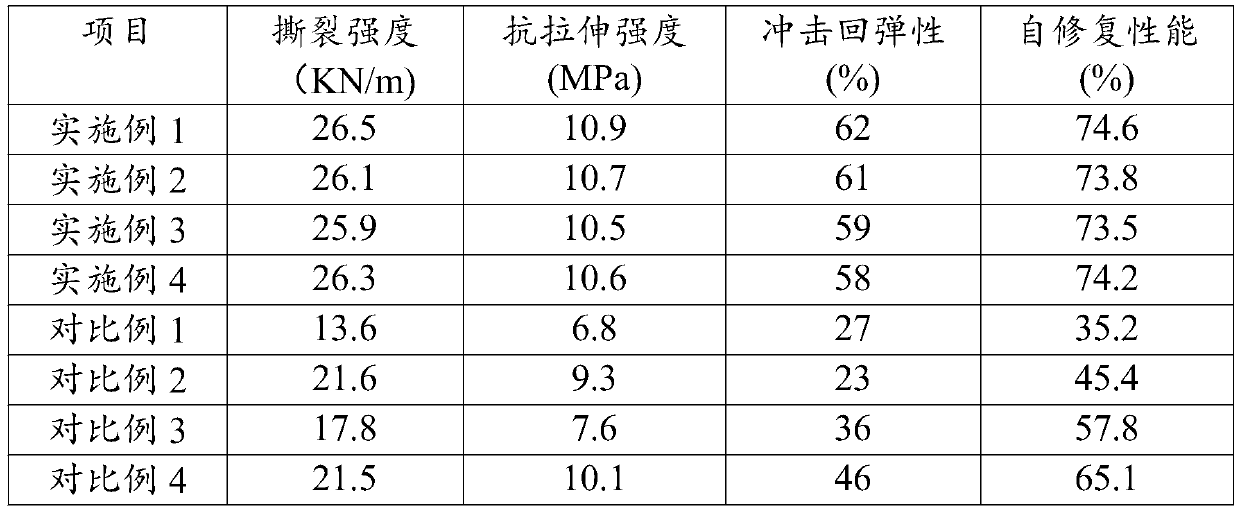Self-repairing environmentally-friendly rubber material and preparation method thereof
An environmentally friendly rubber and self-repairing technology, applied in the field of self-repairing rubber, can solve the problems of no repairing effect, reduced self-repairing performance, and reduced service life of rubber materials, so as to promote uniform and stable vulcanization, raw materials are environmentally friendly, low-toxic, and good The effect of flexibility
- Summary
- Abstract
- Description
- Claims
- Application Information
AI Technical Summary
Problems solved by technology
Method used
Image
Examples
Embodiment 1
[0033] This embodiment provides a self-healing environment-friendly rubber material, which includes the following ingredients in parts by weight: 92 parts of butyl rubber matrix, 26 parts of self-healing filler, 20 parts of toughening and tensile-resistant filler, and 9 parts of vulcanization aid dispersion.
[0034] The vulcanization aid dispersion is composed of the following ingredients in parts by weight: 1.6 parts of zinc oxide, 5.2 parts of bentonite, 0.4 parts of sodium carboxymethylcellulose, 0.9 parts of accelerator TMTD, and 2.3 parts of expanded graphite.
[0035] Wherein the preparation method of self-healing filler comprises the following steps:
[0036] 1) Mix polyether polyol 330N and diamino-terminated linear polydimethylsiloxane uniformly at a mass ratio of 1:1, and then vacuum defoam at 106°C to obtain mixed liquid a; among them, polyether polyol 330N The hydroxyl value is 55-58mg KOH / g, the acid value is ≤0.15mg KOH / g, and the water content is ≤0.1%. The vis...
Embodiment 2
[0047] This embodiment provides a self-healing environment-friendly rubber material, which includes the following ingredients in parts by weight: 95 parts of butyl rubber matrix, 27 parts of self-healing filler, 23 parts of toughening and anti-stretching filler, and 10 parts of vulcanization aid dispersion.
[0048] The vulcanization aid dispersion is composed of the following ingredients in parts by weight: 2.2 parts of zinc oxide, 5.6 parts of bentonite, 0.6 parts of sodium carboxymethylcellulose, 1.1 parts of accelerator TMTD, and 2.1 parts of expanded graphite.
[0049] Wherein the preparation method of self-healing filler comprises the following steps:
[0050] 1) Mix polyether polyol 330N and diamino-terminated linear polydimethylsiloxane evenly according to the mass ratio of 1:0.96, and then vacuum defoam at 107°C to obtain mixed liquid a; among them, polyether polyol 330N The hydroxyl value is 55-58mg KOH / g, the acid value is ≤0.15mg KOH / g, and the water content is ≤0....
Embodiment 3
[0061] This embodiment provides a self-healing environment-friendly rubber material, including the following ingredients in parts by weight: 92 parts of butyl rubber matrix, 25 parts of self-healing filler, 24 parts of toughening and anti-stretching filler, and 10 parts of vulcanization aid dispersion.
[0062] The vulcanization aid dispersion is composed of the following ingredients in parts by weight: 2.6 parts of zinc oxide, 5.6 parts of bentonite, 0.7 parts of sodium carboxymethylcellulose, 1.1 parts of accelerator TMTD, and 2.3 parts of expanded graphite.
[0063] Wherein the preparation method of self-healing filler comprises the following steps:
[0064] 1) Mix polyether polyol 330N and diamino-terminated linear polydimethylsiloxane evenly according to the mass ratio of 1:1.06, and then vacuum defoam at 106°C to obtain mixed liquid a; among them, polyether polyol 330N The hydroxyl value is 55-58mg KOH / g, the acid value is ≤0.15mg KOH / g, and the water content is ≤0.1%. T...
PUM
| Property | Measurement | Unit |
|---|---|---|
| hydroxyl value | aaaaa | aaaaa |
| acid value | aaaaa | aaaaa |
| viscosity | aaaaa | aaaaa |
Abstract
Description
Claims
Application Information
 Login to View More
Login to View More - R&D
- Intellectual Property
- Life Sciences
- Materials
- Tech Scout
- Unparalleled Data Quality
- Higher Quality Content
- 60% Fewer Hallucinations
Browse by: Latest US Patents, China's latest patents, Technical Efficacy Thesaurus, Application Domain, Technology Topic, Popular Technical Reports.
© 2025 PatSnap. All rights reserved.Legal|Privacy policy|Modern Slavery Act Transparency Statement|Sitemap|About US| Contact US: help@patsnap.com

